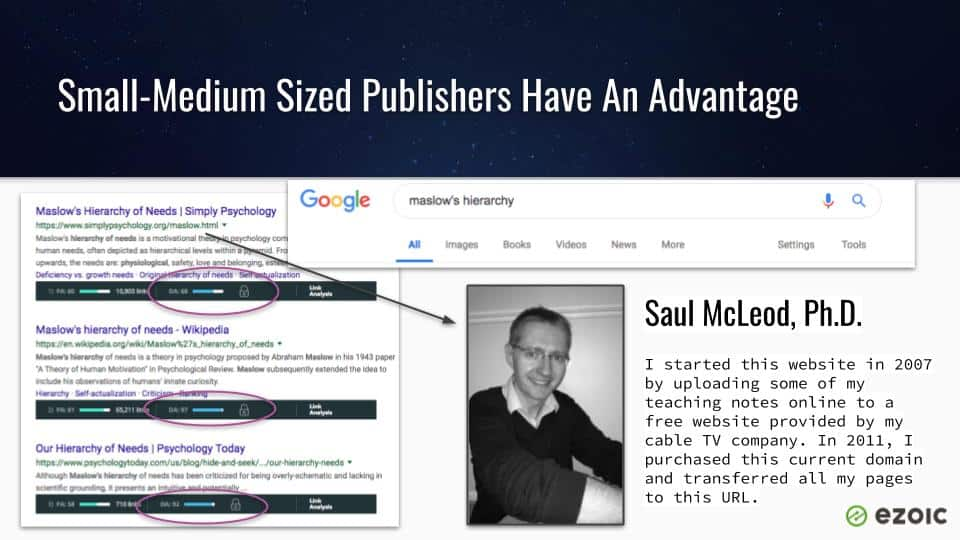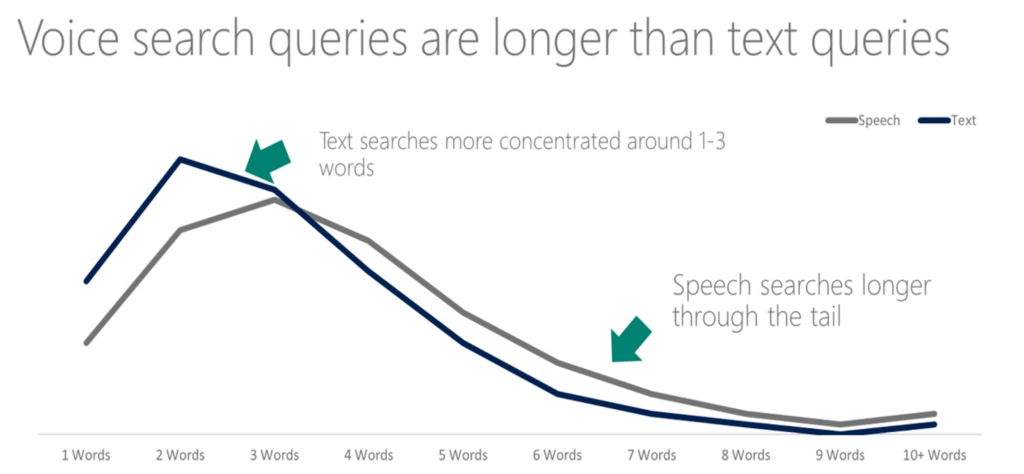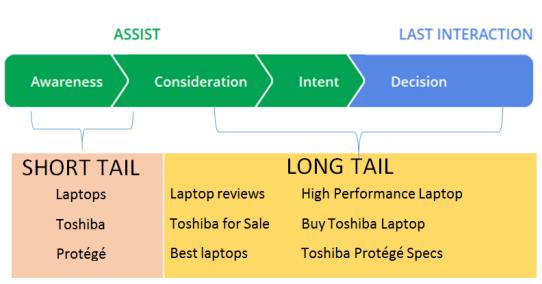
Long-tail keywords are keywords or key phrases that are more specific and usually longer than more commonly used keywords. These keywords receive a lesser volume of search traffic but have a higher conversion value as they are more specific. They gradually increase the traffic to your site and help new and motivated audiences find it.
Ranking for long-tail keywords is much easier because the number of websites competing for them is lower than routine short-tail keywords. The longer and more targeted your keywords are, the easier it is to rank against them on search engine results pages.
Don’t worry. Your content won’t go unnoticed—because of the expanse of the World Wide Web, it is never difficult to find an audience for your specific niche. Also, for desired results, don’t just focus on one keyword. Focus on multiple long-tail keywords together. Doing so will result in a higher volume of overall traffic to your site.
There is another crucial reason to use long-tail keywords. Although searches made using such keywords are lower, those who land on your website through them are highly likely to purchase your product or service.
So, now that you have found the answer to what are long-tail keywords let’s help you find out how to use long-tail keywords.

How to Use long-tail Keywords: A Step-by-step Guide
When you enter the query on how to use long-tail keywords into Google’s search bar, you probably expect easy shortcuts to appear in search results that would help you win the SEO game.
There is one thing to keep in mind here, though: SEO tactics only bring traffic to your site; you won’t have repeat buyers and loyal customers until your product is good.
However, if you are confident that you have developed a great product, and you want to put it out in front of your target audience, then here is a step-by-step guide on how to use long-tail keywords that you can follow:
- Find out the USP of your product
You must figure out what unique your website or product can offer the audience. What is that one quality or attribute which makes it likable? If you take the time to figure this out, it will be easier for you to find fitting long-tail Keywords for your content and make people love and purchase your product. And no, you can’t just identify the product’s USP and consider the job done. You must write it down.
- Think about your mission
Say you are a furniture company. But you deal in unique items crafted using recycled materials. In that case, offering high-quality, eco-friendly furniture is the USP of your company. You can use this as your niche as well. And what do you want for the long term? Say you want to see widespread adoption of green furniture. Well, then this becomes the mission of your venture, and this is what you need to bring to your audience’s notice. However, don’t forget to write down your mission in words that your target audience will understand easily.
- Assess the competitiveness in the market
It’s challenging to rank in some markets. They are highly competitive, and big-shot companies occupy all top slots on search engine results pages. These businesses generally have a massive budget for SEO and other marketing activities. And that’s why beating the competition in such markets is a daunting task. For instance, you will fail to compete in the furniture market with keywords such as “best furniture,” especially if you are a startup or a small- or medium-scale company on a tight marketing budget.
But then, with your mission in mind, defining the differentiating factor of your website or product will be easy. And you will be able to focus on your niche market. Note that your niche and your mission will eventually help you start ranking.
Let’s understand this with the furniture example above. As a furniture company specializing in furniture made of recycled products, your focus will have to be on less competitive terms like “recycled material furniture.” Don’t worry about the grammar of the search terms, as you need to focus on terms your target audience is most likely to understand and use.
Your mission will help you identify the long-term keywords you need to rank for. Your keywords will contain parts or all of the terms you use to describe your mission. Your content ought to be optimized for these terms.
- Undertake audience research
Now that you have your writing mission, you are ready to move on to the next phase of keyword research. The purpose of this step is to list as many long-tail keywords as you can. But before that, it’s crucial to study your audience. Figure out what they want. Figure out the search terms they will likely use for your site or product. Once you have done this, it will be a hundredfold easier to find the best long-tail search terms for your content.
However, if you find all this too complicated, you can also use keyword generators. These tools offer long and short-term keyword suggestions as per users’ needs. They also provide recommendations for key phrases related to your focus keyword.
Additionally, some tools provide you with search volume and trends for the country of your choice. Both content creators and marketers can benefit from these tools.
- Focus on relevance
While the number of people who search for your chosen long-term keywords could be below, they are the ones who are most likely to purchase your product and become your regular customers. So, it’s always profitable to have your website rank for specific terms. However, long-tail keywords will only work if they are closely related to the product you sell as well as the content you are writing.
Now that you know how to use long-tail keywords and find them roll up your sleeves and create great SEO-optimized content. Here is where you can look for SEO blog writing services.
7 Benefits Of Using long-tail Keywords
1. They have better conversion rates

Wondering why use long-tail keywords? Well, they help you cater to the right audience without much hard work.
Note that long-tail keywords are more useful for searching for specific information. Companies often experience higher conversion rates when using long-tail keywords because the content is more relevant to their audiences’ needs.
Here’s an example: You are trying to find a commercial painter to renovate your office. You’ll get many results if you search for a “painting company.” But these results will include both residential and commercial painters, as well as companies that produce paint.
So, instead of using such a generalized term for your search, you can use something more specific like “commercial painting company Seattle, WA” to find painters who specialize in painting commercial properties and work in your city.
Interestingly, long-tail keywords can help visitors make a faster buying decisions.
2. They can help new pages rank quickly, even those with low authority

Google ranks web pages based on several factors, including online authority. Since their pages enjoy greater authority through backlinks, a few industry giants dominate the rankings for keywords having high competition.
That means if your website is new or doesn’t have enough backlinks, you might simply fail to see any desired result even if your content quality is top-notch.
Thankfully, long-tail keywords with more precise search terms can help in this regard. But for these keywords to work as intended, you must produce highly relevant content that answers this search queries better than other pages.
Note that these keywords are less competitive, and you can rank for them without having many backlinks to your blog or page.
3. Long term keywords work better for voice searches

It’s essential to consider how people do searches online. For instance, when it comes to voice searches, people enter queries as though they ask questions to the search bar. This leads to longer keyword searches.
Add voice search tools like Siri and Alexa to the mix, and the conversational element becomes even more compelling.
People doing voice searches to find information generally use long-tail keywords. They use long-tail keywords because they are most likely looking for some specific service. Hence, they can be considered high-intent users, who are precisely the people you need to target.
High-intent users are more likely than others to convert if they find helpful content that answers all their questions.
4. Long-tail keywords also help you rank for short-tail keywords

In addition to the short keywords you are trying to rank for, long-tail keywords often include related short keywords. This combination allows you to achieve both of your goals— ranking for general, short-tail keywords and more targeted, long-tail keywords.
5. They allow you to personalize your content
Let’s look at how long-tail keywords help build great content. The four to five words that make up long-tail keywords are precise and descriptive. For instance, long-tail keywords typically comprise descriptive terms such as gender, nationality, and geographical location around which you can create content to cater to your specific audience.
You can use this unique quality of long-tail keywords to your advantage, as content created with a focus on such keywords is generally relevant to your target audiences’ needs. Contextual marketing allows you to focus more on your content strategy.
6. They help optimize your blog strategy
You can significantly improve your website’s ranking by updating your content regularly. The easiest way to do this is by maintaining a blog that addresses the expectations and needs of your target audience.
You don’t need to feel overwhelmed by the idea of where to start; long-tail keywords can help. They will give you an insight into your audience’s search habits. As a result, you will be able to create valuable content that addresses their problems and requirements by using highly targeted long-tail keywords.
7. They can increase the visibility of your content
Google personalizes search results for long-tail keywords based on location, age, and interests. Meaning two users may receive different results for the exact search term. Since long-tail keywords are more specific, they can help you optimize your website to appeal to different types of searchers.
Also, because there is less competition, long-tail keywords are easier to rank for. Search Engine Land estimates that 70% of web search traffic comes from long-tail keyword searches. And yet, it is so easy to overlook them in your marketing strategy. But remember, when you do not focus on them, you miss a huge opportunity to drive quality web traffic to your website.
Optimizing on-page SEO with long-tail keywords is a common yet highly useful digital marketing strategy. However, if you have only heard that it drives traffic to sites, then there’s a lot more that you need to know.
Long-tail keywords are useful for identifying the most popular questions that your target audience asks. This allows you to gain insight into what your potential customers might be looking for. Gaining such deep customer insights can help you create a great customer journey that ends at conversion.
Long-tail keywords can also be a great addition to your multi-platform content marketing strategy. Your audience should be able to find value wherever they are, not just on your website. So, create quality blog posts and social media posts using highly targeted long-tail keywords to entice people to your site, answer their queries, and solve their problems. This will improve your ranking and build trust in your customers for your brand.
Key Takeaways
- long-tail keywords get less search traffic but have a higher conversion value.
- Although these keywords are frequently searched, the visitor that finds your website through them is more likely to buy your service or product.
- Defining the USP of your product and identifying your goals is highly important to find the right long-tail keywords for your content.
- Long-tail keywords have better conversion rates.
- Long-term keywords work best for voice searches.

FAQs
Long-tail keywords have longer, more specific phrases. People browsing through the internet are more likely to use them when they are about to purchase something or when they are using the voice search feature.
There are numerous benefits of using long-tail keywords. Some of them are improved content visibility, a higher volume of targeted traffic, optimization of your blog strategy, and so on.
Keyword stuffing, also known as spamdexing or web spam, is an unfair practice of loading a webpage with keywords without considering their appropriateness to the context of the content. Keyword stuffing is usually done to help a site rank high on search engine pages.
Some examples of long-tail keywords would be:
1. Buy breathable running socks
2. Organic coffee shops near me
3. Best phone models 2022
4. Best bakeries in San Francisco
While short-tail keywords are for general searches, long-tail keywords lead to more specific searches and are longer than short-tail keywords. From a business perspective, targeting long-tail keywords specific to the business or its geographical location is more likely to lead to conversions.
Latest Blogs
Learn how to rank on AI search engines like ChatGPT, Perplexity, and Gemini by optimizing your content for authority, structure, and relevance. Stay ahead in AI-driven search with this strategic guide.
Explore the best healthcare SEO services for your medical practice. Improve online visibility and effectively reach more patients in need of your services.
Discover top social media agencies specializing in banking solutions, enhancing financial services and driving engagement.
Get your hands on the latest news!
Similar Posts

B2C Marketing
5 mins read
Top Choices for Best Content Marketing Services in B2B Industries

Artificial Intelligence
5 mins read
How A Lead Generation Specialist Can Use AI-Powered Content Funnels to Drive Conversions

Artificial Intelligence
4 mins read